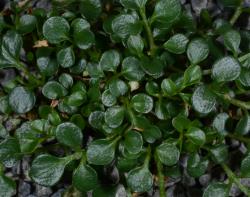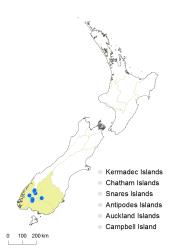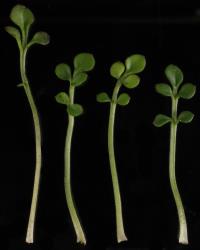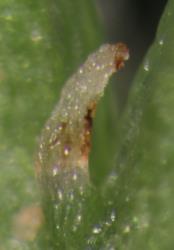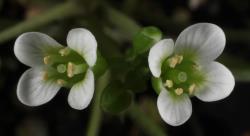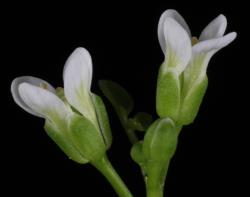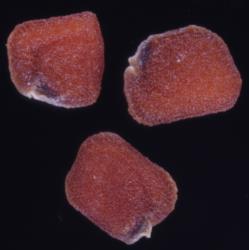Perennial herb, single rosette or multiple rosettes on short lateral branches, stem and branches 1.0–2.0 mm diam., rhizomatous. Leaves up to 60 mm long, pinnatifid; lamina 3.5–12.0 × 2.4–9.0 mm, green, glabrous, coriaceous, obovate to broadly elliptic; petiole up to 46 mm long, plano-convex, glabrous. Terminal pinna 3.0–7.7 × 2.8–8.6 mm, orbicular-reniform to deltoid-reniform, sometimes with 1–2 shallow lobes, margin usually with 2 lateral hydathodes, apex obtuse with a distinct hydathode; base cuneate, obtuse or truncate. Lateral pinnae 2–6, 0.5–4.5 × 0.8–3.5 mm, orbicular, orbicular-obovate to obovate, petiolule up to 0.5 mm long, hydathode up to 0.3 mm in axil. Cauline leaves sometimes present, subtending proximal flowers or inserted on lower peduncle, smaller and narrower than rosette leaves. Inflorescence racemose, often with 2–5 lateral racemes, each 6–14-flowered; peduncle 8–150 mm long, 1.0–1.6 mm diam. At base, ascending, glabrous. Pedicels 4.0–15.0 mm long, 0.5–0.7 mm diam., stout, glabrous but often with axillary hydathodes. Sepals 2.2–4.2 × 1.0–1.4 mm, elliptic-oblong to elliptic, ± saccate, green and sometimes flushed red-brown at apex, glabrous, margin white and membranous, apex obtuse, base truncate. Petals 4.5–7.0 × 0.9–2.0 mm, white, limb obovate; apex obtuse; base cuneate, tapering to a 1.5–2.5 mm long claw. Stamens 6; median filaments 4, 2.8–3.8 mm long; lateral filaments 2, 2.4–3.6 mm long; anthers 0.6–0.7 mm long, cream to pale yellow, when dehiscent held at a similar height to or slightly below the stigma. Ovary 2.5–4.5 mm long, 0.5–0.7 mm diam., ± terete, green, glabrous; ovules 10–16; style 0.9–1.2 mm long, ± terete; stigma 0.4–0.5 mm diam. Siliques 16.0–20.0 × 1.5–2.0 mm, glabrous, style 1.3–1.5 mm long, valves green at maturity, replum 0.5–0.6 mm wide. Seeds 1.0–1.4 mm long, 0.9–1.1 mm wide, 0.3–0.4 mm thick, broadly oblong-orbicular to orbicular-rectangular, orange-brown; wing present, usually towards base, c. 0.1 mm wide, pale grey; with thick-walled reticulate cells.
Cardamine eminentia is distinguished from C. coronata by its compact growth habit, smaller, glabrous and coriaceous leaves, shorter inflorescences, cream to pale yellow anthers, broader siliques, and the seeds having a thick-walled reticulum.
South Island: Otago, Southland, Fiordland.
Cardamine eminentia is known from the Livingston Mountains (e.g., Mt Cerberus), Tākitimu Mountains, East Dome, and Mt Luxmore (west of Lake Te Anau).
Cardamine eminentia grows on ultramafic, volcanic and limestone scree, rock debris and fellfield.
Cardamine eminentia is assessed as having a conservation status of At Risk–Naturally Uncommon, with the qualifiers Data Poor and Sparse (de Lange et al. 2018). The qualifier Data Poor is applied because although there are populations on different mountain ranges, the base-rich habitat seems quite specific and the number and size of the populations are not known with certainty.
Flowering December–January; Fruiting January–February.



